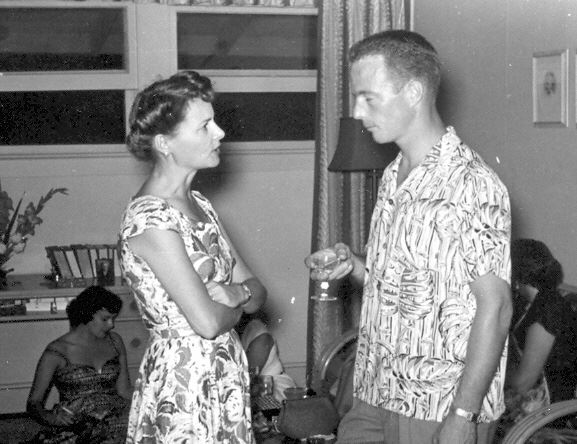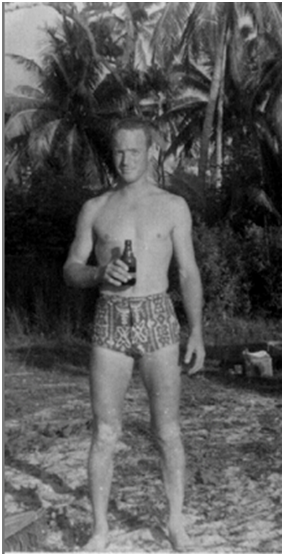Remembering Scott Carpenter
by Charles Pomeroy
Astronaut/aquanaut Scott Carpenter of Mercury 7 and Sealab fame died on October 10, 2013, as the whole world knows from the many obits appearing in the media. The whole world knows, too, of his many accomplishments, so I will not repeat them here. As for his life story, much of it can be found in his book, "For Spacious Skies,”co-authored with his daughter Kris Stoever and published in 2002 by Harcourt (Harcourt Books.com).
Barely mentioned, if at all, in the obits is the fact that Scott Carpenter’s career as a naval aviator began as a Blue Shark. An ensign, he joined the squadron, then forward-based at Atsugi, in mid-November of 1951 and took part in the last two months of our second deployment to Japan. After our return to Barbers Point in January of 1952, we picked up new aircraft in Alameda and flight crews were reorganized. This was in preparation for deployment of the squadrons 12 P2V-3s to Kodiak in July of that year.
Crew 7 photo taken in Kodiak, 1952
It was our good fortune to have Scott Carpenter assigned to Crew 7, with W. John St. Marie as PPC, prior to our deployment to Kodiak.And it was Scott Carpenter’s good fortune as well, for St. Marie excelled at boosting people, including the writer of this article. Carpenter, as a fledgling aviator and our navigator at the time, benefited from St. Marie’s generosity in giving him cockpit time. That experience soon led to the right-hand seat and eventually to PPC, but the latter was well after I left the squadron in March of 1953.
There is no doubt that Scott Carpenter was sharp. As a navigator, he was not only accurate, but also thinking ahead. One event in particular remains in my aging memory. This occurred during radar mining exercise on the windward side of Oahu. Our approach to the target was made at very low altitude to evade radar, then an easy climb to an altitude just high enough to pick up the target at 20 miles out. Everything was fine until I lost the target at a critical point. Immediately after I informed the pilot, Carpenter jumped in with an “I’ve got it,” saying he could take us over target. As the navigator he had been clocking us in and had both course and time to target. Fortunately, with a bit more altitude, that blip was regained a few minutes later. Scotty, as he was known to fellow officers, turned out to be spot on.
Mission briefing for Crew 7 in Kodiak, 1952. This photo was taken prior to one of our patrols off the east coast of the USSR, with a stopover in Adak.
I can also expand on another incident, one that is recounted on page 123 of "For Spacious Skies.” In October of 1952 we were returning to Kodiak from Adak, where we had overnighted after running a patrol along the east coast of the USSR. At an altitude of 9,000 feet or so, with some rather magnificent clouds for viewing, there was a sudden brilliant flash throughout our P2V-3. No doubt everyone momentarily felt as I did, that this was the end. But the sound of those two engines still turning over, droning on, soon filled the ears. Being a smartass, I was the first to react by picking up the mike and saying, “Pass the toilet paper.”
Inspecting the plane for damage after landing we found that a bolt of lightning had left a dent under the nose guns and melted a string of holes running down toward the bomb bay doors. Indeed, it was an incident none of us will forget. Scott Carpenter certainly did not, for he quotes my comment in his book.
In any event, we were all more than ready to leave Kodiak in mid-January of 1953. BE-7 and its crew were among the squadron planes that would fly
non-stop down to Barbers Point. Two days before our departure Crew 10 had shown it could be done, flying directly to BP from Adak with a two-hour communications gap being the only problem. Apparently the weight on their trailing-wire antenna had been lost, according to Dick Neufeld, the navigator on that flight. Crew 7’s flight would be without Scott Carpenter, however, for he had elected to fly in another aircraft, one taking the West Coast route.
This information came from Richard “Dick” Pickering, also a fledgling naval aviator who had joined the squadron in May, 1950. Pickering had participated in all our Korean War deployments as well as the one to Kodiak, by which time he had advanced to PPC of Crew 12. The reason he opted for the Alameda route, he wrote in an email, was to visit his parents, who lived there, as well as to pick up “auto tires, potatoes and strawberries” for people in Hawaii. Scott wanted to go via Alameda also, wrote Pickering, and joined his crew.
As Pickering describes it, “There were four pilots, with Scott as my co-pilot, on the trip from NAS Alameda in California to Barbers Point in Hawaii. It was interesting since no one on board had performed any navigation for some time. We relied on Dead Reckoning (DR) navigation and our homing equipment to get us there. Unfortunately, the homing equipment was not picking up the signal from Hawaii and our wind information was questionable for accurate DR navigation. Fortunately, we were flying a very loose formation with another aircraft. That aircraft was somewhere south of us.
“To the south of us there was considerable weather including a line of thunder storms. We were in the clear. I asked the other aircraft if they were able to home in on Hawaii. They told me their signal was very good. I did not want to tell them that we were unsure of our position, so I asked how their weather was. They told me they were flying in a line of thunder storms. It was then clear to us that we were flying north of our desired flight path and altered our heading to intercept the flight path of the other aircraft. To our relief, we finally picked up the Hawaii signal dead ahead and made it home safe and sound.
” Pickering’s other contact with Scott was “routine work and flying stuff and our non-work functions with Scott and his wife Rene. Both were every nice people.”
In this connection he sent the below picture of Scott taken in Hawaii in 1952 by
Bill Brink, the Intelligence Officer, at a “Change of Command” party to say farewell to CDR Howard and to greet CDR Moynahan following the squadron’s return from its second deployment to Japan.
 Scott Carpenter chatting with June Howard, the wife of Commanding Officer of VP-6, Guy Howard, in 1952
Scott Carpenter chatting with June Howard, the wife of Commanding Officer of VP-6, Guy Howard, in 1952
Unfortunately, Pickering wrote, “I had the duty that day and briefly attended the party in my uniform – picture below drinking water with my wife.” Part of his description of that era, "Moment in Time," can be found on the VP-6 website under“Sea Stories.”That chapter is from his autobiographical book of the same title published in 2010.
Rich Pickering, in uniform, as Duty Officer was limited to drinking water during a brief visit to a VP-6 party in 1952.
Below is a photo of Scott Carpenter enjoying a beer on the beach near his rental home early in 1952. Although not dated, this photo was probably taken prior to moving into base housing at Barbers Point that summer. Exploring the ocean with local friends was the starting point for his interest in oceanography, according to his book.
 Scott Carpenter enjoying a beer on the beach near his rental home early in 1952.
Scott Carpenter enjoying a beer on the beach near his rental home early in 1952.Exploring the ocean with local friends was the starting point for his interest in oceanography.
My personal relationship with Scott Carpenter did not extend beyond our being members of the same flight crew. And that is something all former Blue Sharks will know about. He was all business, efficient, and unassuming. My memory of him is primarily that of a navigator, a job at which he excelled. But then, with one exception (who took us to the brink), all navigators I flew with during my six years in flight crews in four different patrol squadrons were very, very good. All I can say in closing is
RIP, Scotty, I know you are in good company up there